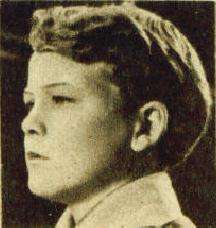George Ernest
| George Ernest | |
|---|---|
 | |
| Born |
George Ruud Hjorth November 20, 1921 Pittsfield, Massachusetts, United States |
| Died |
June 25, 2009 (aged 87) Whittier, California, United States |
| Occupation | Actor |
| Years active | 1930–1942 |
George Ernest (November 20, 1921 – June 25, 2009) was an American actor and World War II Office of Strategic Services (OSS) combat photographer/cameraman.[1] He appeared in more than 60 films between 1930 and 1942.
Early life
He was born George Ruud Hjorth to a Norwegian mother and Danish father. The family moved to California when he was two and a half years old. His father owned a restaurant in Hollywood.[1]
Acting career
Hjorth began getting small parts in silent films when he was just three years old.[1] He had a successful career as a child actor, being a member of Our Gang in 1931. He also played Roger Jones in 17 Jones Family low-budget films from 1936 to 1940 (named Roger Evers in the first movie, Every Saturday Night). However, as he grew older, roles became scarcer, so he learned from cameramen on his films and became one himself.
World War II
When the Japanese attacked Pearl Harbor on December 7, 1941, and the United States entered World War II, he enlisted. At a friend's suggestion, he became a combat photographer and "one of the 17 original movie makers" of a special OSS photographic unit headed by noted film director John Ford.[1] He had to sign an agreement not to discuss his wartime work for 50 years.[1]
On his first combat mission, he photographed the fighting in North Africa, followed by the invasion of Sicily and then on to the Italian mainland.[1] He parachuted "into France and Germany ... to take pictures of bridges, roads, rivers, railroads and even a V-1 launch site".[1]
In early June 1944, he parachuted into occupied France with three film cameras without being told what he was supposed to do.[1] The French Resistance hid him for a couple of days, then took him to the coast before dawn of June 6. He was told he would know what to film. As dawn came up, he witnessed, and filmed, the D-Day invasion of Omaha Beach by the United States Army - the only known Allied footage from the German perspective.[1] After using up all of his film, he managed to get through the American lines unharmed and returned to England. Absurdly, when the film was to be screened, he was ordered out of the room because he did not have the top secret clearance required to see it.[1]
Hjorth also shot pictures of Buchenwald concentration camp and the aftermath of an Axis atrocity in France (the corpses of dozens of civilians burned alive).[1]
Post-war
He became an executive for McDonnell Douglas.[1] When OSS files became declassified, his wartime activities came to light. Historians are searching for the film he shot, so far without success.[1]
He died on June 25, 2009, in Whittier, California.
He was one of the subjects in two documentaries - The Our Gang Story (1994)[2] and Shooting War (2000),[3] about World War II combat cameramen - and episode 9 of the TV series Brad Meltzer's Lost History.
Partial filmography
- Sunny Side Up (1929) (uncredited)
- Fly My Kite (1931 short)
- The Star Witness (1931)
- Shiver My Timbers (1931 Our Gang short)
- Destry Rides Again (1932)
- Speed Demon (1932)
- Little Men (1934)
- The Mystery of Edwin Drood (1935)
- Dinky (1935)
- The Plainsman (1936)
- Every Saturday Night (1936)
- Lady Behave! (1937)
- Motor Madness (1937)
- Quick Millions (1939)
- Four Sons (1940)
- Golden Gloves (1940)
- Meet the Missus (1940)
- Petticoat Politics (1941)
- Remember the Day (1941)
- Stardust on the Sage (1942)
References
- 1 2 3 4 5 6 7 8 9 10 11 12 13 H. G. Reza (October 23, 1998). "The Mystery of the Missing Film". Los Angeles Times.
- ↑ The Our Gang Story at the Internet Movie Database
- ↑ Shooting War at the TCM Movie Database
Bibliography
- Goldrup, Tom and Jim (2002). Growing Up on the Set: Interviews with 39 Former Child Actors of Film and Television. McFarland & Co. p. 67-75. ISBN 1476613702.
- Holmstrom, John (1996). The Moving Picture Boy: An International Encyclopaedia from 1895 to 1995. Norwich: Michael Russell, p. 108-109.